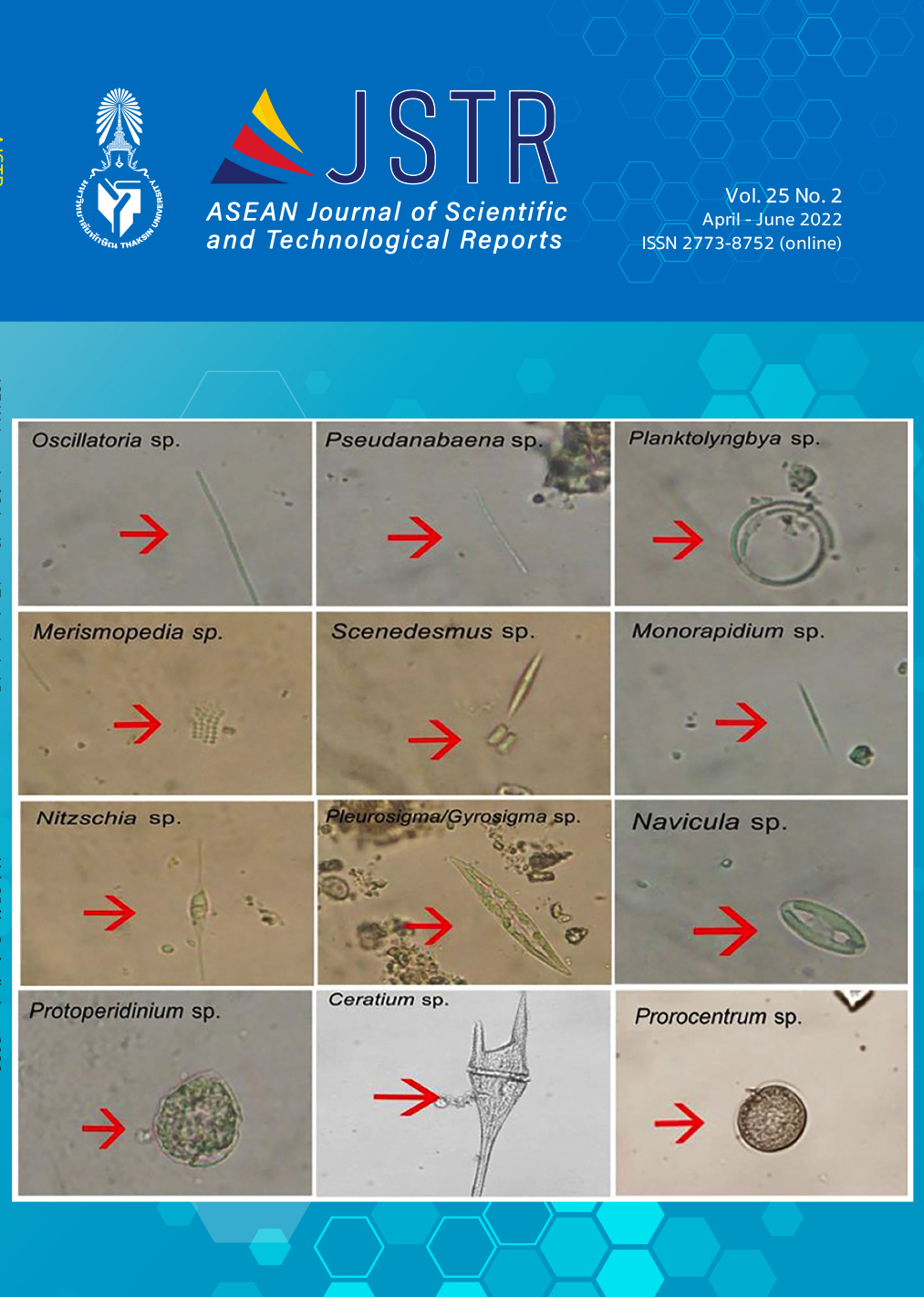Effect of Probiotic Used on Phytoplankton Community Structure in White Shrimp (Litopenaeus vannamei) Pond
Main Article Content
บทคัดย่อ
Probiotic use is one major approach to eliminating waste accumulation in shrimp farming. This study investigated the effects of probiotic use on the abundance and diversity of phytoplankton at the farm level. The results revealed 4 divisions for 12 genera of phytoplankton, consisting of Cyanophyta (Oscillatoria sp., Pseudanabaena sp., Planktolyngbya sp. and Merismopedia sp.), Chlorophyta (Scenedesmus sp. and Monorapidium sp.), Bacillariophyceae (Nitzschia sp., Pleurosigma/Gyrosigma sp. and Navicula sp.) and Pyrrophyta (Protoperidinium sp., Ceratium sp. and Prorocentrum sp.). Pyrrophyta exhibited the highest density, followed by Cyanophyta, Bacillariophyta and Chlorophyta. The cell density of 4 divisions was high at the start rearing e.g., Pyrrophyta 47,991 cells/L (85%), Cyanophyta 3,141 cells/L (5%), Bacillariophyta 3,530 cells/L (6%), and Chlorophyta 1,965 cells/L (3%). However, the density drastically changed at the end of the study in 19 days, especially in Pyrrophyta, for which cell density dropped to 4,705 cells/L (48%). The density of Cyanophyta increased towards day 7 and decreased at the end of the study (2,126 cells/L, 22%). The density of Bacillariophyceae and Chlorophyta were reduced in the initial cultivation from day 1 to day 10 but increased again before the end of the study for 1,176 cells/L (12%) and 1,698 cells/L (18%). The research indicates that adding probiotics to shrimp ponds can affect the abundance of the phytoplankton community. Probiotics can reduce an abundance of Pyrrophyta and Cyanophyta (biotoxin producing group.), while they show a trend to increase an abundance of Chlorophyta and Bacillariophyta.
Article Details

This work is licensed under a Creative Commons Attribution-NonCommercial-NoDerivatives 4.0 International License.
References
Pinoargote, G.; Flores, G.; Cooper, K.; Ravishankar, S. Effects on survival and bacterial community composition of the aquaculture water and gastrointestinal tract of shrimp (Litopenaeus vannamei) exposed to probiotic treatments after an induced infection of acute hepatopancreatic necrosis disease. Aquaculture Research. 2018; 49, 3270–3288.
Castine, S. A.; McKinnon, A. D.; Paul, N. A.; Trott, L. A.; de Nys, R. Wastewater treatment for land-based aquaculture: improvements and value-adding alternatives in model systems from Australia. Aquacult Environ Interact. 2013, 4, 285–300. https://doi.org/10.3354/aei00088.
Verschuere, L.; Rombaut, G.; Sorgeloos, P.; Verstraete, W. Probiotic bacteria as biological control agents in aquaculture. Microbiology and Molecular Biology Reviews. 2000; 64, 655–671.
Padmavathi, P.; Sunitha, K.; Veeraiah, K. Efficacy of probiotics in improving water quality and bacterial flora in fish ponds. African Journal of Microbiology Research. 2012; 6, 7471–7478.
Wang, R.; Guo, Z.; Tang, Y.; Kuang, J.; Duan, Y.; Lin, H.; Jiang, S.; Shu, H.; Huang, J. Effects on development and microbial community of shrimp Litopenaeus vannamei larvae with probiotics treatment. AMB Express. 2020; https://doi.org/10.1186/s13568-020-01041-3.
Meng, N.; Ju-lin, Y.; Mei, L.; Zhi-min, G. Assessment of water quality and phytoplankton community of Limpenaeus vannamei pond in intertidal zone of Hangzhou Bay, China. Aquac. Rep. 2018; 11, 53–58.
Napiórkowska-Krzebietke, A. Phytoplankton as a basic nutritional source in diets of fish. Journal of Elementology. 2017; 22, 831–841.
Akter, S.; Rahman, Md. M.; Faruk, A.; Bhuiyan, Md. N. M.; Hossain, A.; Al-Asif, A. Qualitative and quantitative analysis of phytoplankton in culture pond of Noakhali district, Bangladesh. International Journal of Fisheries and Aquatic Studies. 2018; 6, 371–375.
de Paiva-Maia, E.; Alves-Modesto, G.; Otavio-Brito, L.; Olivera, A.; Vasconcelos-Gesteira, T. C. Effect of a commercial probiotic on bacterial and phytoplankton concentration in intensive shrimp farming (Litopenaeus vannamei) recirculation systems. Latin American Journal of Aquatici Research. 2013; 41, 126–137. https://doi.org/103856/vol41-issue1-fulltext-10.
Yusoff, F. M.; Zubaidah, M. S.; Matias, H. B.; Kwan, T. S. Phytoplankton succession in intensive marine shrimp culture ponds treated with a commercial bacterial product. Aquaculture Research. 2002; 33(4), 269–278. https://doi.org/10.1046/j.1355-557x.2002.00671.x.
Mercurio, A. L.; Querijero, B. L.; Ching, J. A. Phytoplankton community in aquaculture and non-aquaculture sites of Taal lake, Batangas, Philippines. Journal of Experimental Biology and Agricultural Sciences. 2016; 4(1), 66–73. https://doi.org/10.18006/2016.4(1).66.73
Yusoff, F. Md.; Matias-Peralta, H.; Shariff, M. Phytoplankton population patterns in marine shrimp culture ponds with different sources of water supply. Aquatic Ecosystem Health & Management. 2010; 13(4), 458–464. https://doi.org/10.1080/14634988.2010.525163.
Lukwambe, B.; Qiuqian, L.; Wu, J.; Zhang, D.; Wang, K.; Zheng, Z. The effects of commercial microbial agents (probiotics) on phytoplankton community structure in intensive white shrimp (Litopenaeus vannamei) aquaculture ponds. Aquaculture International. 2015; 23(6), 1443–1455. https://doi.org/10.1007/s10499-015-9895-6.
Gribble, K. E.; Nolan, G.; Anderson, D. M. Biodiversity, biogeography and potential trophic impact of Protoperidinium spp. (Dinophyceae) off the southwestern coast of Ireland. Journal of Plankton Research. 2007; 29(11), 931–947. https://doi.org/10.1093/plankt/fbm070.
Ju, Z. Y.; Forster, I.; Conquest, L.; Dominy, W.; Kuo, W. C.; Horgen, F. D. Determination of microbial community structures of shrimp floc cultures by biomarkers and analysis of floc amino acid profiles. Aquaculture Research. 2008; 39, 118–133. https://doi.org/10.1111/j.1365-2109.2007.01856.x.
Case, M.; Leca, E. E.; Leitao, S. N.; Sant’Anna, E. E.; Schwamborn, R.; de Moraes, A. T. Plankton community as an indicator of water quality in tropical shrimp culture ponds. Marine Pollution Bulletin. 2008; 56(7), 1343–1352. https://doi.org/10.1016/j.marpolbul.2008.02.008.
Paerl, H. W.; Tucker, C. S. Ecology of blue-green algae in aquaculture ponds. Journal of the World Aquaculture Society. 1995; 26, 109–131. https://doi.org/10.1111/j.1749-7345.1995.tb00235.x.
Rajinikanth, T.; Ramasamy, P.; Ravi, V. Efficacy of probiotics, growth promotors and disinfectants in shrimp grow out farms. World Journal of Fish and Marine Sciences. 2010; 2(3), 208–215.

